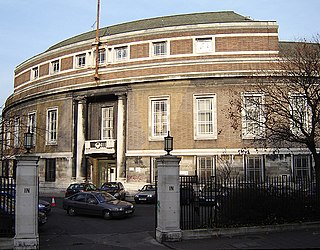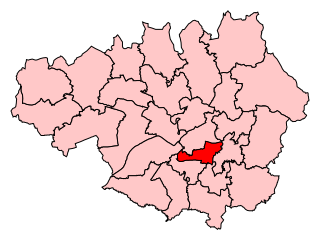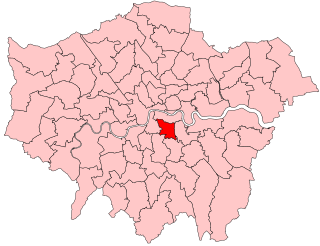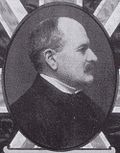
The Metropolitan Borough of Stoke Newington was a metropolitan borough in the County of London between 1900 and 1965 when it became part of the London Borough of Hackney.

Manchester Gorton was a constituency represented in the House of Commons of the UK Parliament. It was the safest Labour seat in Greater Manchester by numerical majority and one of the safest in the country.

South Norfolk is a constituency in the House of Commons of the UK Parliament represented by Ben Goldsborough, a member of the Labour Party, after winning the seat in the 2024 general election.

Hackney North and Stoke Newington is a constituency represented in the House of Commons of the United Kingdom since 1987 by Diane Abbott, a member of the Labour Party who served as Shadow Home Secretary from 6 October 2016 to 5 April 2020. Abbott was one of the first three Black British MPs elected, and the first female Black British MP in the UK.

The region of Greater London, including the City of London, is divided into 75 parliamentary constituencies which are sub-classified as borough constituencies, affecting the type of electoral officer and level of expenses permitted. Since the general election of July 2024, 59 are represented by Labour MPs, 9 by Conservative MPs, 6 by Liberal Democrat MPs, and 1 by an independent MP.
The parliamentary borough of Finsbury was a constituency of the House of Commons of the UK Parliament from 1832 to 1885, and from 1918 to 1950. The constituency was first created in 1832 as one of seven two-seat "metropolis" parliamentary boroughs other than the two which already existed: Westminster and the City of London; the latter until 1885 retained an exceptional four seats. Finsbury was directly north of the City of London and was smaller than the Finsbury division of the Ossulstone hundred but took in land of Holborn division to its southwest in pre-introduction changes by Boundary Commissioners. It included Finsbury, Holborn, Moorfields, Clerkenwell, Islington, Stoke Newington and historic St Pancras. The 1918 constituency corresponded to the smaller Metropolitan Borough of Finsbury ; it was a seat, thus electing a single member, fulfilling a longstanding aim of Chartism which underscored the 1832 reforms.
Hackney was a two-seat constituency in the House of Commons of the UK Parliament created under the Representation of the People Act 1867 from the former northern parishes of the Tower Hamlets constituency and abolished under the Redistribution of Seats Act 1885.

Balham and Tooting was a constituency in South London, which returned one Member of Parliament (MP) to the House of Commons of the Parliament of the United Kingdom. It was created for the 1918 general election and abolished for the 1950 general election.

Clapham was a borough constituency in South London which returned one Member of Parliament (MP) to the House of Commons of the UK Parliament. It was created in time for the 1885 general election then altered in periodic national boundary reviews, principally in 1918, and abolished before the February 1974 general election. In its early years the seat was officially named Battersea and Clapham Parliamentary Borough: No. 2—The Clapham Division.

Peckham is a borough constituency in South London which returns one Member of Parliament (MP) to the House of Commons of the Parliament of the United Kingdom. Elections are held using the first-past-the-post voting system.

Salford South was a parliamentary constituency in the City of Salford in Greater Manchester from 1885 until 1950. It returned one Member of Parliament (MP) to the House of Commons of the Parliament of the United Kingdom.
Hackney South was a parliamentary constituency in "The Metropolis". It was represented by nine Members of Parliament to the House of Commons of the Parliament of the United Kingdom, only two of whom, Horatio Bottomley and Herbert Morrison, were elected more than once.

Hampstead was a borough constituency, centered on the Hampstead area of North London. It returned one Member of Parliament (MP) to the House of Commons of the Parliament of the United Kingdom, who was elected using the first-past-the-post voting system.

Newton was a parliamentary borough in the county of Lancashire, in England. It was represented by two Members of Parliament in the House of Commons of the Parliament of England from 1559 to 1706 then of the Parliament of Great Britain from 1707 to 1800 and of the Parliament of the United Kingdom from 1801 until its abolition in 1832.
Birmingham West was a parliamentary constituency represented in the House of Commons of the Parliament of the United Kingdom. It returned one Member of Parliament (MP), elected by the first-past-the-post voting system.
Stretford was a parliamentary constituency in North West England, which returned one Member of Parliament (MP) to the House of Commons of the Parliament of the United Kingdom.

Brixton was a parliamentary constituency centred on the Brixton district of South London. It returned one Member of Parliament (MP) to the House of Commons of the Parliament of the United Kingdom, elected by the first-past-the-post system.

Lambeth North was a borough constituency centred on the Lambeth district of South London. It returned one Member of Parliament (MP) to the House of Commons of the Parliament of the United Kingdom, elected by the first past the post system.

Wolverhampton West is a borough constituency in the city of Wolverhampton in the West Midlands of England which was re-established for the 2024 general election following the 2023 Periodic Review of Westminster constituencies and which is formed largely from the former Wolverhampton South West constituency. It has been represented in the House of Commons since 2024 by Warinder Juss.
West Ham North was a borough constituency in the County Borough of West Ham, in what was then Essex but is now Greater London. It returned one Member of Parliament (MP) to the House of Commons of the Parliament of the United Kingdom, elected by the first-past-the-post voting system.





















